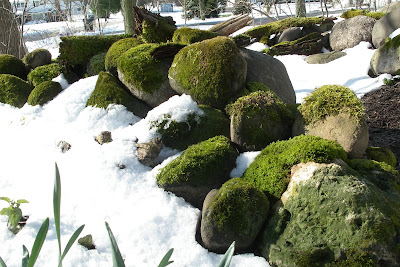The patio on a sunny day
These photos were taken recently of the patio on a sunny day. Generally, I take photos on overcast days so I don't have such high contrast (from sunny to shady areas). Cameras simply don't seem to have the capacity of the human eye to perceive details in shaded areas. Anyhow, the sun provides such vividness in garden scenes, so on occasion I take some photos in sunlight. Of course, the back lawn, in direct sun, was washed out when I exposed for the shaded areas.The patio has a lower area (shown) and an upper area (not shown), both surfaced with antique paving bricks that were used in Milwaukee streets in the early 1900s. I collected thousands of these for free in 1973 when Forest Home Avenue on the south side of Milwaukee was rebuilt. The bricks were laid on about four inches of sand.
I do two things differently than almost everyone else who uses such bricks. First, I leave a gap of about a half inch between each brick. This both looks better, I think, and provides more coverage. Second, I have the sand recessed about a half inch below the surface. This, too, I believe, improves the appearance because it adds a third dimension. I can't take credit for this, as I saw this done in the late 1970s in Toronto.
The planter in the left background is constructed of granite cobblestones. These were used in city streets in the late 1800s. I got about 300 of them in 1987 from someone who had them in his back yard. When I asked how much he wanted for them, he said, "Oh, just give me a couple of cases of Pabst Blue Ribbon." Deal!




































